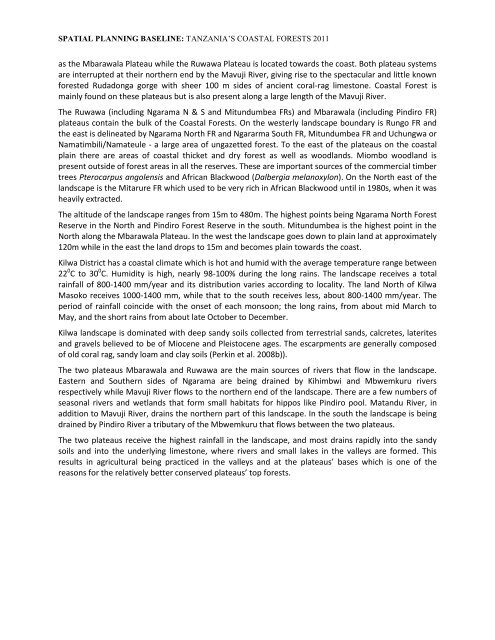Neil D. Burgess, Paul Harrison, Peter Sumbi, James Laizer, Adam ...
Neil D. Burgess, Paul Harrison, Peter Sumbi, James Laizer, Adam ...
Neil D. Burgess, Paul Harrison, Peter Sumbi, James Laizer, Adam ...
You also want an ePaper? Increase the reach of your titles
YUMPU automatically turns print PDFs into web optimized ePapers that Google loves.
SPATIAL PLANNING BASELINE: TANZANIA’S COASTAL FORESTS 2011<br />
as the Mbarawala Plateau while the Ruwawa Plateau is located towards the coast. Both plateau systems<br />
are interrupted at their northern end by the Mavuji River, giving rise to the spectacular and little known<br />
forested Rudadonga gorge with sheer 100 m sides of ancient coral-rag limestone. Coastal Forest is<br />
mainly found on these plateaus but is also present along a large length of the Mavuji River.<br />
The Ruwawa (including Ngarama N & S and Mitundumbea FRs) and Mbarawala (including Pindiro FR)<br />
plateaus contain the bulk of the Coastal Forests. On the westerly landscape boundary is Rungo FR and<br />
the east is delineated by Ngarama North FR and Ngararma South FR, Mitundumbea FR and Uchungwa or<br />
Namatimbili/Namateule - a large area of ungazetted forest. To the east of the plateaus on the coastal<br />
plain there are areas of coastal thicket and dry forest as well as woodlands. Miombo woodland is<br />
present outside of forest areas in all the reserves. These are important sources of the commercial timber<br />
trees Pterocarpus angolensis and African Blackwood (Dalbergia melanoxylon). On the North east of the<br />
landscape is the Mitarure FR which used to be very rich in African Blackwood until in 1980s, when it was<br />
heavily extracted.<br />
The altitude of the landscape ranges from 15m to 480m. The highest points being Ngarama North Forest<br />
Reserve in the North and Pindiro Forest Reserve in the south. Mitundumbea is the highest point in the<br />
North along the Mbarawala Plateau. In the west the landscape goes down to plain land at approximately<br />
120m while in the east the land drops to 15m and becomes plain towards the coast.<br />
Kilwa District has a coastal climate which is hot and humid with the average temperature range between<br />
22 0 C to 30 0 C. Humidity is high, nearly 98-100% during the long rains. The landscape receives a total<br />
rainfall of 800-1400 mm/year and its distribution varies according to locality. The land North of Kilwa<br />
Masoko receives 1000-1400 mm, while that to the south receives less, about 800-1400 mm/year. The<br />
period of rainfall coincide with the onset of each monsoon; the long rains, from about mid March to<br />
May, and the short rains from about late October to December.<br />
Kilwa landscape is dominated with deep sandy soils collected from terrestrial sands, calcretes, laterites<br />
and gravels believed to be of Miocene and Pleistocene ages. The escarpments are generally composed<br />
of old coral rag, sandy loam and clay soils (Perkin et al. 2008b)).<br />
The two plateaus Mbarawala and Ruwawa are the main sources of rivers that flow in the landscape.<br />
Eastern and Southern sides of Ngarama are being drained by Kihimbwi and Mbwemkuru rivers<br />
respectively while Mavuji River flows to the northern end of the landscape. There are a few numbers of<br />
seasonal rivers and wetlands that form small habitats for hippos like Pindiro pool. Matandu River, in<br />
addition to Mavuji River, drains the northern part of this landscape. In the south the landscape is being<br />
drained by Pindiro River a tributary of the Mbwemkuru that flows between the two plateaus.<br />
The two plateaus receive the highest rainfall in the landscape, and most drains rapidly into the sandy<br />
soils and into the underlying limestone, where rivers and small lakes in the valleys are formed. This<br />
results in agricultural being practiced in the valleys and at the plateaus’ bases which is one of the<br />
reasons for the relatively better conserved plateaus’ top forests.

















